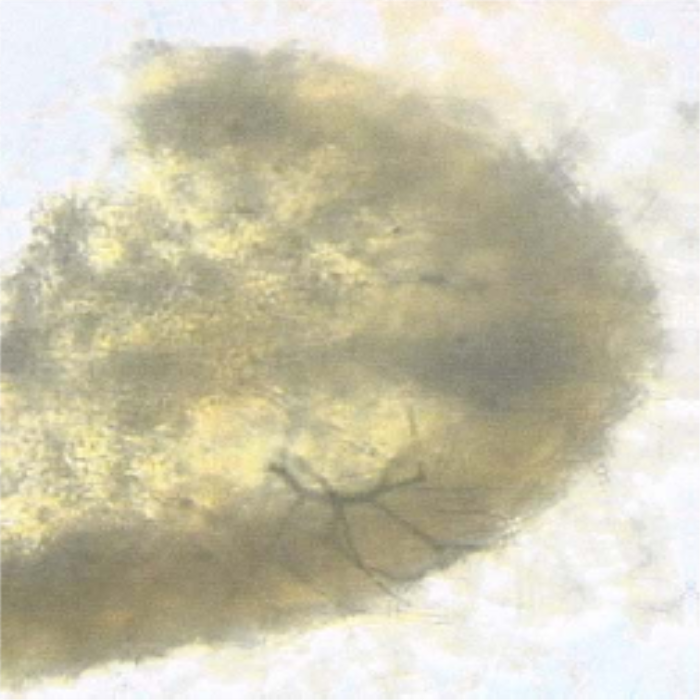
Teucrium stocksianum / الجعدة
Ja`adah, Togreyern, Mekhzani, Toum Alhayiah, Ja`aidah, Sa`atar Alhir, Gadha
Mountain Germander
Ja`adah
Lamiaceae

Flowers

Herbarium Sample
Ethnobotanical Characteristics
Description
Dense, compact, aromatic perennial herb, hemispherical in outline up to 30 cm high and across, rootstock woody, stems erect very much branched and whitish in color. Leaves simple, opposite or in whorls, sometimes packed very densely on stems, 0.5- 1.5cm long, sessile , oblong to linear, grey green; with hairs on both surfaces, margin crenate, distinct midribs, inside branches usually leafless. Flowers in terminal racemose inflorescences, small and white creamy to pinkish in color, with darker pink veins, upper lip 2- lobed, arching, with protruding stamens, larger lower lip 3-lobed. Fruit nut with 4 nutlets.
Habitat & Distribution
North Africa, Iran, Pakistan, Arabia and Mediterranean zone. In UAE the plant is found in rocky habitats: wadis and hillsides and compact fine textured soils with stones and pepples at all elevations.
Part(s) Used
Aerial parts and flowering heads
Traditional & Medicinal Uses
In folk medicine the plant is astringent, expectorant, tonic, depurative, febrifuge, stimulant, vulnerary, appetizer, hypoglycemic, and infusion of aerial parts is used for stomachache and intestinal problems , feminine sterility, steam bath for colds and fever, and for malaria. In UAE the plant is very well known and used for skin, stomach and Kidney problems ,renal colic, colds, fever and diabetes.
Pharmacognosy and Phytochemistry
Parts studied
Aerial parts (leaves, floral parts)
Microscopical Description
Leaf: Transverse section of the leaf shows a two-wing-like structure with the two rounded margins as the edges of the wings slightly curving downwards towards the lower surface. The leaf is unilateral and the upper epidermis consists of small rectangular cells though they are markedly sinuous in surface view with thin cell walls. It is covered with a thick striated somewhat raised cuticle. The epidermal cells contain many angular and spherical amorphous masses and coloured materials. The diacytic stomata are oval to rounded in shape and are few in number. The upper epidermis bears numerous branched trichomes that have thick warty walls and also simple tapering conical trichomes. Relatively long glandular trichomes with two to four celled stalks and spherical heads with raised cuticles also exist. The palisade tissue consists of about two layers of oblong, loosely packed parenchyma cells. The spongy mesophyll consists of oblong to pear-shaped loosely held cells not constituting definite layers. Both palisade and spongy tissues contain coloured amorphous and crystalline masses. The lower epidermis consists of very small rectangular cells. From a surface view they have wavy, thin and somewhat beady cell walls. The lower epidermis has relatively more branched trichomes compared to the upper one but both have equally distributed glandular trichomes. Floral parts: Microscopically, the floral parts show similar features as those of the leaf but the floral parts namely corolla, have extremely dense branched covering and glandular trichomes; the former are more warty. Epidermal cells are smaller and rectangular in shape and many are papillose. Cells contain more coloured substances and brownish pigments. Vessels are narrower, smaller in size and commonly annularly thickened (DPS ZCHRTM unpublished results).

a) TS of leaf

b) Upper epidermis

c) Portion of floral part
- (a). General TS of the leaf showing its typical structure, different zones, glandular and covering trichomes (less on the upper surface and dense on the lower one).
- (b). Surface view of the leaf upper epidermis showing the sinuous cell walls of the epidermal cells, bases of covering trichomes, coloured cellular contents and part of the underlying palisade layer.
- (c). A portion of a floral part in surface view. (Magnifications: All x 400).
Organoleptic characteristics
Appearance: Solid powder
Colour: Light brownish yellow
Odour: Aromatic
Taste: Very bitter
Physicochemical constants
Loss in weight on drying at 1050C (%): 8.30
Solubilities (%)
Alcohol solubility: 3.60
Water solubility: 5.60
10% ethanolic extractive: 32.00 – 34.00
Ash values (%)
Total ash: 11.40 - 12.40
Water soluble ash: 2.00 - 2.20
Acid-insoluble ash: 2.20 - 2.60
Successive extractive (%)
Petroleum ether (60-80C): 2.40- 3.35
Chloroform: 6.85-7.90
Absolute alcohol: 6.80- 8.90
pH values
pH of 1% solution: 5.93
pH of 10% solution: 5.32
The above results have appeared as publication(Kamil et al. 19999, DPS ZCHRTM unpublished results).
Chemical constituents
Germacrene, sabinene, -pinene, -cadinino, linalool, gurisol, methylated flavones, diterpenoids. (Kamil et.al 1999, DPS, ZCHRTM unpublished results, Rizk, 1986).
Pharmacological and Toxicological studies
There are a number of species of the genus Teucrium. T. polium has been studied well scientifically. The boiled extract of the T. polium was found to inhibit the spontaneous contractile activity of rabbit ileal smooth muscle. T. stocksianum showed significant anti-gastric ulcer activity, cytoprotective activity, anti-inflammatory activity and caused progressive impairment of neuromuscular coordination in mice. T. mascatense has been reported to show homeostasis of glucose in normal and STZ diabetic rats.
Teucrium polium was studied on writhing test, a visceral pain model in mice. This study confirms the antivisceral pain properties of T. polium comparable to those of hyoscine and indomethacin and suggests a good place for it in antispasmodic therapies in human. (Abdollahi et. al., 2003). The study suggests that T. capitatum can induce acute hepatocellular necrosis, which could be clinically confused with acute viral hepatitis, and that some medicinal plants are not as safe as they are popularly known. (Dourakis, et. al., 21002).
Among the plants consumed was Teucrium chamaedrys (germander), which has been associated with several cases of hepatotoxicity (Perez, 2001). Significant hepatotoxicity has also been observed after the ingestion of tea or capsule of Teucrium chamaedrys (Larry et. al., l999; Stickel, 2001). Treatment with the plant extract produced no statistically significant effect on the plasma biochemical variables that are considered indices of liver and kidney function. (Tanira, et. al 1997). Teucrium buxifolium species have displayed significant antiulcer and cytoprotective activity (Fernandez, et. al., l997).
Hepatoprotective activity of an ethanolic extract of Teucrium stocksianum was investigated against paracetamol-induced hepatic damage in mice. T. stocksianum did not produce any lethality or adverse effects in the livers of treated mice. These results indicate that T. stocksianum ethanolic extract contains hepatoprotective constituents (Rasheed, et. al, 1995). The Teucrium polium boiled leaf extract produced an intestinal motility and blood pressuring in experimental animals (Suleiman et. al., 1988). An ethnobotanical survey showed that the plant is effective against cancer and prostate disorders (Ali-Shtayeh et. al., 2000).
The pharmacological and toxicological studies carried out in our laboratory and the results in brief, on Teucrium stocksianum (10% ethanolic extract) have been given below. The results presented without references showed unpublished data (unpublished results, DBMS, ZCHRTM).
|
ACTIVITY |
RESULTS |
|
Anti-inflammatory activity-Rat paw oedema |
Extract showed significant anti inflammatory activity (Islam et. al., 1990a;Islam et.al., 1990b). |
|
Anti-inflammatory activity -Cotton pellet |
Extract showed significant anti inflammatory activity (Islam et. al., 1990a;Islam et. al., 1990b). |
|
Anti-inflammatory activity-Rat paw oedema (Topical) |
Extract showed significant anti inflammatory activity (Islam et. al., 1990a;Islam et. al., 1990b). |
|
Antinociceptive activity-Tail flick |
Extract showed significant anti nociceptive activity. |
|
Antinociceptive activity-Hot plate method |
Extract showed significant antinociceptive activity. |
|
Antinociceptive activity-Writhing |
Extract showed significant antinociceptive activity. |
|
Studies on gastric ulcers-Indomethacin induced |
Showed significant gastroprotective effect(Islam et. al., 1999c). |
|
Studies on gastric ulcers- phenylbutazone induced |
Showed less pronounced gastro protective effect (Islam et. al., 1999c). |
|
Studies on gastric ulcers- NaOH induced |
Showed very significant gastro protective effect (Islam et. al., 1999c). |
|
Studies on gastric ulcers-Alcohol induced |
Showed very significant gastro protective effect (Islam et. al., 1999c). |
|
Studies on gastric ulcers-Cold stress induced |
Produced less pronounced gastro protective effect (Islam et. al., 1999c). |
|
Anti-secreatory activity-Gastric acidity |
Showed no anti-secretary effect (Islam et. al., 1999c). |
|
Anti-diabetic activity-STZ |
Extract showed significant anti-diabetic activity (Islam et. al., 1999d). |
|
Gross behavioral studies- Tremor/Twitches |
No toxic symptoms (Islam et. al., 2000). |
|
Gross behavioral studies-Writhing |
No toxic symptoms were observed acute administration (Islam et. al., 2000). |
|
Gross behavioral studies- Diarrhea, Urination |
Mortality was recorded at higher doses on sub acute and sub chronic administration (Islam et. al., 2000). |
|
Mortality |
No mortality was recorded (Islam et. al.,2000). |
|
Acute toxicity studies- |
Produced mild toxic signs appeared (Islam et. al., 2000). |
|
LD50 evaluation |
>32 g/kg. (Islam et. al., 2000). |
|
Hematological studies |
Produced no significant change in hematological parameters (Islam et. al., 2000). |
|
Biochemical studies |
SGOT, SGPT increased; CPK reduced(Islam et. al., 2000). |
|
Effect on body weight |
No significant change (Islam et. al., 2000). |
|
Effect on vital organ weight |
Caused a slight increase in liver weight intreated animals(Islam et. al., 2000). |
|
Teratogenicity |
No teratogenic effect was observed.; No maternal toxicity observed; Mild foeto toxicity was seen (Islam et. al., 2000). |
|
Mutagenicity |
Extract did not show mutagenic effect(Clastogenic activity) in the model studied at the dose tested (Islam et. al., 2000). |
Summary of the results
Teucrium stocksianum showed significant antigastric ulcer, hepatoprotective; antidiabetic activities; Teucrium significantly reduced blood pressure on i.p. administration in anesthetized rats. Teucrium has also been studied for its safety evaluation studies, including acute, sub-acute, sub-chronic toxicity studies and also including teratogenicity and mutagenicity evaluation.
References
- Abdollahi M, Karimpour H, Monsef-Esfehani HR. (2003) Antinociceptive effects of Teucrium polium L. total extract and essential oil in mouse writhing test. Pharmacol Res. 48(1): 31-5.
- Ali-Shtayeh MS, Yaniv Z, Mahajna J. (2000) Ethnobotanical survey in the alestinian area: a classification of the healing potential of medicinal plants. J Ethnopharmacol. 73(1-2): 221-32.
- Department of Biomedical Sciences, Zayed Complex for Herbal Research and Traditional Medicine, Unpublished results.
- Dourakis SP, Papanikolaou IS, Tzemanakis EN, Hadziyannis SJ. (2002) Acute hepatitis associated with herb (Teucrium capitatum L.) administration. Eur J Gastroenterol Hepatol. 14(6): 693-5.
- El-Ghonemy, A. A. Encyclopedia of Medicinal Plants of the United Emirates. (1993) 1st Edition, University of UAE.
- Fernandez Puntero B, Iglesias Peinado I, Villar del Fresno AM. (1997) Anti-inflammatory and antiulcer activity of Teucrium buxifolium. J Ethnopharmacol. 55(2): 93.
- Ghazanfar, S. A. Handbook of Arabian Medicinal Plants.(1994) Library of Congress.
- Islam, M.W., Zakaria, M.N.M., Radhakrishnan, R., Kamil,, K.C. Chan, Attas, A. (2002) Effect of Teucrium stocksianum on Gastric Ulceration and Secretion in rats. Pharmaceutical Biology, p. 40 –45.
- Islam, M.W., M.N.M. Zakaria, R. Radhakrishnan, A. Ismail, X.M. Liu, K. Chan and M. Habibullah. Preliminary studies on the anti-diabetic effect of Teucrium stocksianum Boiss. (Fam. Labiatae) in streptozotocin diabetic mice. J Pharm Pharmacol. 1999, 51 (Suppl): 342.
- Islam, M.W., Radhakrishnan, R, Liu, X.M., Chen, H.B. , Al-Naji, M.A. Safety evaluation of Zizyphus spina-Christi L. and Teucrium stocksianum Boiss, used in traditional Medicine in the Arabian gulf. International Congress and 49th Annual Meeting of the Society for Medicinal Plant Research (Gesellschaft for Arzneipfianzenforschung), September 2-6, 2001, Erlangen, Germany.
- Jongbloed, M.V. The Comprehensive Guide to the Wild Flowers of the united Arab Emirates, Erwda, (2003) Emirates Printing Press, Dubai, U.A.E.
- Kamil M , Ahmad F, Jayaraj A F, Guanasekhar C J, Samuel S, Chan K & Habibullah M. Physicochemical standardisation of Jaada (Teucrium stocksianum) “ 2000 Years of Natural Products Research- Past, Present and Future,” Amsterdam. Abstract No: 564, July 1999.
- Larry D, vial T, Pauwels, P. (l992). hepatitis after germender (Teucrium chamedrys) administration; Another evidence of herbal hepatotoxicity. Ann. Med. 1992, 117, 129-132.
- Miller A.G., Morris M. Plants of Dhofar, The southern Region of Oman: Traditional, Economic and Medicinal Uses.(1987) Office of the Advisor for conservation of the Environment, Sultanate of Oman.
- Perez Alvarez J, Saez-Royuela F, Gento Pena E, Lopez Morante A, Velasco Oses A, Martin Lorente J. (2001) Acute hepatitis due to ingestion of Teucrium chamaedrys infusions Gastroenterol Hepatol. 24(5): 240-3.
- Radhakrishnan, R., M.N.M. Zakaria, M.W. Islam X.M. Liu, A. Ismail, M. Habibullah and K. Chan. Anti-inflammatory activity of Teucrium stocksianum. “2000 Years of Natural Products Research – Past Present and Future”, Amsterdam, July 26-30 1999.
- Rasheed RA, Ali BH, Bashir AK. ( 1995) Effect of Teucrium stocksianum on paracetamol-induced hepatotoxicity in mice. Gen Pharmacol. 26(2): 297-301.
- Rizk, The Phytochemistry of the Flora of Qatar, Scientific and Applied Research Centre, Univ. of Qatar,Qatar,1986.
- Stickel F, Seitz HK, Hahn EG, Schuppan D. (2001) Liver toxicity of drugs of plant origin Z Gastroenterol. 39(3): 225-32, 234-7.
- Suleiman MS, Abdul-Ghani AS, Al-Khalil S, Amin R. ( 1988) Effect of Teucrium polium boiled leaf extract on intestinal motility and blood pressure. J Ethnopharmacol. 22(1): 111-6.
- Tanira MO, Ali BH, Bashir AK, el-Sabban FF, Al Homsi M. (1997) Neuromuscular and icrovascular changes associated with chronic administration of an extract of Teucrium stocksianum in mice. J Pharm Pharmacol. 49(3): 301-4.
- Western, A. R. The Flora of United Arab Emirates, an introduction. (1986) Publication of the UAE University.
